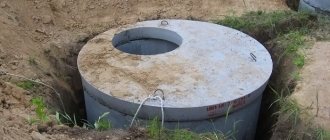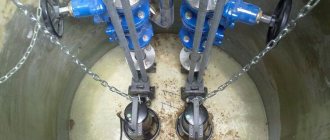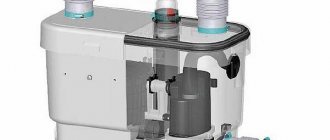Features of underground drains
Before installing sewerage equipment in a suburban area, it is important to understand the structural features and functioning mechanism of underground drains.
The best drainage option for a summer house or country house is a cesspool or septic tank. In any case, silt deposits and various impurities will gradually accumulate here, which require periodic pumping. Even modern septic tanks do not always cope with the destruction of bacteria in waste, although they are quite expensive. Because of this, a cesspool remains an affordable and easy-to-maintain drainage option. For cleaning purposes, underground structures are equipped with an entrance for a sewage disposal truck or connected to a sewage pump, which allows you to carry out the necessary procedures independently and without the involvement of specialized equipment.
It is only important to first familiarize yourself with the rules and nuances of connecting cleaning equipment. Untimely cleaning of a cesspool can lead to serious problems, including the creation of unfavorable sanitary conditions in the area, harming the soil and human health.
Purpose of the fecal pump
Silty and solid deposits do not evaporate, but accumulate on the walls of cesspools and the surface of the soil. They contain a large number of bacteria that infect people when using the toilet, as well as surrounding plants when they get into the soil. It is to eliminate sewage, maintain optimal sewerage operation and a favorable sanitary environment that fecal pumps are designed.
As the owner of a summer house or a private house, most likely you are already well acquainted with various types of pumping equipment, which is used to water the area and supply hot and cold water to the house, including for year-round heating. Sewage plants operate on a similar principle, pumping and then grinding sewage from a sewage facility.
It is worth noting that conventional water pumps are not suitable for such purposes: their impeller quickly becomes clogged with large particles from the wastewater, and therefore the electric motor may simply fail. It is special fecal units that are designed for efficient processing of solid waste, since they are equipped with a grinder that can cope even with particularly large-sized contaminants. High-tech models of such equipment are not cheap, so a homemade analogue can always come to the rescue, which will meet all the characteristics necessary to perform important work.
DIY sewer pumping
Manual cleaning is used when:
- the volume of extracted wastewater is insignificant;
- the purpose of pumping is only to extract active sediment;
- mechanical cleaning in the presence of an autonomous sewage system;
- it is not possible to organize access to the sewerage system for special equipment;
- financial restrictions (no funds for vacuum cleaner services).
The general requirement when performing self-pumping is to take care of waste disposal in advance. Usually, a sealed container is used for this, often a sewage pumping barrel (plastic, rarely metal), with the help of which wastewater is transported to the place of its disposal.
Methods for self-pumping sewerage
There are two options:
Manual sewer pumping
The work is carried out with the mandatory use of protective equipment, and several people need to be involved (for safety reasons). Pumping occurs without a pump. The liquid component of the wastewater is removed with a bucket, and the sludge component with a bucket and shovel. Also, deposits on the walls of the receiving container are removed mechanically.
The choice in favor of this method is usually made at the dacha, where sewage disposal is unavailable or too expensive.
The disadvantages include: extremely unpleasant work, the presence of odors, the possibility of polluting the surrounding area of the site, the duration of the procedure. As reviews indicate, few people have the patience to complete the procedure in full, which is why the frequency of its implementation increases.
Pumping out sewerage using a sump pump
The rather high purchase price pays for itself in one pumping. And you don’t need any skills to operate the pump.
Advice. A technique such as mixing the wastewater using improvised means will help to effectively remove bottom sludge.
We recommend material on the topic - pumping out septic tanks, cesspools and sewer wells
What you need to assemble the pump yourself
The design of a homemade fecal pump is relatively simple. To begin with, you should familiarize yourself with the main components and their purpose, and understand the principle of operation of the equipment. To assemble it, you will need certain tools and parts, which can be found in inexpensive supermarkets for summer residents (and some, perhaps, borrowed from neighbors):
- a simple household submersible pump (it is best to choose a device of the “Kid” modification);
- metal slats;
- fine mesh;
- strong twine;
- welding machine.
Please note that when assembling a sewer pump yourself, you do not need to disassemble the base pump unit in an attempt to change its technical characteristics. The required functionality can be achieved by installing a filtration mesh on the inlet pipe, due to which the device will allow particles of solid impurities to pass through only the appropriate size.
Assembly and installation of equipment
To begin with, it should be noted that a homemade fecal pump is suitable exclusively for cleaning sewage drains in small private or country houses. In large buildings with a complex sewer system, it is still better to install professional equipment. Work on assembling the unit with your own hands should be carried out in the following order:
- Make a cage for the future pumping device by welding a steel frame from metal slats and stretching a mesh with small cells over it, which will act as a grinder. The mesh should not be too fine: the optimal cell size is 1x1 cm. Due to this design, the pumping equipment will not become clogged with large particles, and the unit will cope with all impurities without any problems.
- Tie strong twine or cable to the top of the cage.
- Place the pump in the cage and place it in the desired location.
Please note that the installation of the unit must be carried out strictly in the central part of the cesspool, otherwise the pumping equipment will not pump the sludge layers, but simply destroy them. In addition, with this arrangement, the device will be protected from clogging by fatty substances located on the surface.
To avoid failure of a homemade device, it is necessary to clean it monthly and replace the filter. To clean the fecal pump from fatty contaminants, it is enough to use hot water. Remove the pumping device from the pit and place it in a container with boiling water for 5-10 minutes. This time is enough to dissolve the fatty deposits.
How much does it cost to pump out a sewer in a private home?
If, with the manual method, only the initial costs of purchasing a pump and barrel are taken into account, and not the costs associated with the disposal of pumped out wastewater, then the cost of the services of a vacuum cleaner is calculated taking into account many factors, among them:
- location of a country house. The farther you are from the city (the location of the organization providing sewer services), the more expensive it will be to call a car due to transportation costs;
- volume of the sewer tank. The larger the receiver capacity, the more wastewater will be pumped out, so you need to either hire a car with a large tank, or call two cars;
- location for installing the drainage pit. If it is impossible to access the pumping site, use a long hose. This factor also affects the price;
- time to call the vacuum cleaner. In case of emergency pumping, the call may be made outside of working hours, for which you will have to pay extra;
- duration of operation of the machine;
- Additional services.
Approximate prices for vacuum cleaner services in the table
Cost of sewer service for pumping sewerage in a private house
Note. Signing a sewerage service agreement will reduce the overall cost of the work (a discount for the company’s commitment) and improve the quality of its execution.
Installation of a pump in systems with a septic tank
Installing a pump in sewer systems with a septic tank is also a simple and quick job that you can easily handle on your own. The assembled pumping equipment should be placed in the well immediately after completion of its arrangement. To create a minimum gap between the intake hole and the bottom of the treatment facility, special metal holders are used on the pump body. To ensure reliable and efficient operation of the device, you can hang it on a strong steel cable or use a special support structure.
As an outlet pipe, it is best to use a PVC pipe with a diameter of 6 to 7.5 cm, which is connected to the pump without sealing the connection. The use of a flexible hose is not allowed, since prolonged use of such a product can lead to clogging of the pipe.
To prevent backflow of waste after turning off the device, the pump must be equipped with a check valve embedded in the pipeline. If it is necessary to preserve the sewage system, for example, for the winter, an additional shut-off valve is installed. It should be located behind the check valve. Before leaving for a long time, this valve must be closed to distinguish between the fecal pump and external drains. If the outlet pipeline is planned to be used intensively in winter, it should be carefully insulated.
The pumping unit is connected through the electrical panel. The latter must necessarily include the following protective devices:
- grounding;
- circuit breaker;
- Remote Control;
- device for forced switching on and off of the pump.
In the event of frequent power outages in the house, it is important to take care to ensure the uninterrupted functioning of the pumping equipment. To do this, the device is connected to a gasoline or diesel generator of the required power.
How to choose?
There is a large selection of products, so it is worth deciding on the purpose and area of use. Only with this approach will it be possible to make the right choice. To avoid wasting money, study the power characteristics, the number of possible connections, the frequency of waste removal, etc.
How to calculate power
The pump power is recorded in the technical documentation. The main role is played by the height and distance over which the device can transfer wastewater.
The indicators are mutually exclusive. If the pump moves the mass upward to the maximum possible height, then it will no longer be able to move them to the distance specified in the passport. Each meter rise reduces the movement range by 10m.
Fecal pump power
On average, a high-quality device lifts a mass by 10 m and moves it horizontally by 100 m. Select a device with a power reserve. If the pump constantly works at maximum, the additional load may damage it. If the pump is constantly operated “at the limit of its capabilities,” this will significantly reduce its service life.
Number of possible connections
Manufacturers provide models with one connection or combined ones, which allow you to connect several drains at once. The best option is to install the pump on the toilet and connect the remaining drains to it. In this case, the device must have a chopper and sufficient power to cope with the assigned volume of work.
Frequency of waste disposal
Two device models are presented:
- With float type switch. When the amount of waste accumulates to a certain level, the shredder turns on.
- After each press of the button, the grinding blades are activated.
If the size of the sewer pipe does not match the cross-section of the inlet pipes, you will need to use an adapter.
Which brand should you prefer?
Grundfos, SFA and JEMIX products have earned the trust of many users. Manufacturers offer a wide selection of models with different characteristics, each product excels in something.
Number of connection points and pump performance
SFA SANIBROYEUR SILENCE allows you to connect several devices. Power 550 W, productivity -5 m3/hour. Provides a lift of up to 4 meters, which is quite enough for the operation of plumbing fixtures in the apartment. Cost -17560 rubles.
Effluent temperature
The JEMIX pump is designed for pumping hot wastewater, the temperature of which is within 90 degrees. Raises drains to a height of 7 meters, made of durable materials. Cost 7900 rubles.
Diameter of nozzles and pipes
The variety of modifications of GRUNFOS SOLOLIFT allows you to choose a device for a country house or apartment, taking into account the diameter of the pipe and pipes.
Sewage pumping range
UNIPUMP SANIVORT 600 will ensure the movement of masses horizontally by 80 meters, vertically by 8 meters. Capacity 6 m3 per hour. Involves connecting several drains at once. Cost – 11,500 rubles.
Starting and setting up pumping equipment
As soon as all the work on installing the pipeline, assembling and installing sewage pumping equipment, as well as connecting to the power supply is completed, it is time to test the installed system. An important step is to regulate the level at which the automatic float switch will turn off the device in emergency situations.
Begin to gradually fill the cesspool or septic tank with water, adhering to the minimum liquid level allowed for this equipment. Continue to fill the tank slightly above the appropriate level. If the installation was completed correctly, the sensor will operate and the pumping equipment will start.
It is better to conduct several tests of the device to ensure its reliability and performance. If you find the slightest problem, return to the initial stage of work, checking that each step was performed correctly. If the tests are successful, close the receiving well. Now the sewer system is completely ready for operation.











